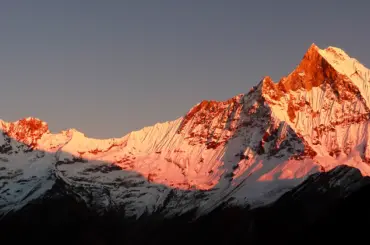Detail Itinerary
Day 1: Arrival in Kathmandu
Your adventure begins as you land at Tribhuvan International Airport in Kathmandu, Nepal. Upon arrival, you will be warmly welcomed by our representative and transferred to your hotel. You’ll have some time to rest and recover from your travels. The evening is yours to explore the vibrant streets of Kathmandu and savor the local culture. You will stay overnight at the hotel with a bed and breakfast (B/B) plan.
Day 2: Drive to Pokhara (or Fly, per your preference)
After breakfast, you will embark on a picturesque drive to Pokhara. Alternatively, if you prefer, you can take a scenic flight to Pokhara, which offers stunning views of the Himalayas. Upon reaching Pokhara, you will check into your hotel. The rest of the day is free for you to relax or explore the charming lakeside city at your leisure. You will stay overnight at the hotel with a B/B plan.
Day 3: Drive to Tikhedhunga and Trek to Ghorepani
Today, you’ll start your trekking adventure. After breakfast, you’ll drive to Tikhedhunga, where your trek begins. The trail takes you through picturesque villages, terraced fields, and lush forests. Your destination is Ghorepani, a charming village nestled in the heart of the Annapurna region. You’ll stay overnight in Ghorepani with a full board (B/B/L/D) plan.
Day 4: Ghorepani to Tatopani Early in the morning, you’ll hike to Poon Hill to witness a breathtaking sunrise over the Himalayas. Afterward, you’ll return to Ghorepani for breakfast before continuing your trek. Today’s journey takes you to Tatopani, known for its natural hot springs. You can relax and rejuvenate in these soothing waters, providing a well-deserved break for tired muscles. You will stay overnight in Tatopani with a full board (B/B/L/D) plan.
Day 5: Tatopani to Ghasa
As you resume your trek, the trail leads you through picturesque villages and forests. You’ll follow the Kali Gandaki River, which flows through the deepest gorge in the world. The day’s trek brings you to the village of Ghasa, where you’ll stay overnight. Your meals, including breakfast, lunch, and dinner, are included (B/B/L/D).
Day 6: Ghasa to Marpha
Today’s journey takes you to Marpha, a charming village renowned for its apple orchards and apple-based products, including apple brandy. You’ll trek through scenic landscapes, enjoying the serene beauty of the region. Upon reaching Marpha, you can explore the village and savor the local delicacies. You will stay overnight in Marpha with a full board (B/B/L/D) plan.
Day 7: Marpha to Kagbeni
Leaving Marpha behind, you’ll continue your trek to Kagbeni. This village is the gateway to the Upper Mustang region and is known for its Tibetan-influenced culture and architecture. You can explore the village and immerse yourself in its unique atmosphere. You’ll stay overnight in Kagbeni with a full board (B/B/L/D) plan.
Day 8: Kagbeni to Muktinath
Your trek takes you to Muktinath, a place of great religious significance for both Hindus and Buddhists. Muktinath is home to the sacred Muktinath Temple, believed to cleanse pilgrims of their sins. The journey offers panoramic views of the surrounding mountains and pristine landscapes. You will stay overnight in Muktinath with a full board (B/B/L/D) plan.
Day 9: Muktinath to Jomsom
After a visit to Muktinath Temple, you’ll trek to Jomsom, the administrative center of the Mustang region. The trail offers a unique blend of cultural exploration and natural beauty. Upon reaching Jomsom, you can explore the town and unwind. You will stay overnight in Jomsom with a full board (B/B/L/D) plan.
Day 10: Drive to Pokhara by jeep/bus (flight is optional )
Today, you’ll have a drive from Jomsom to Pokhara, offering stunning aerial views of the Annapurna and Dhaulagiri mountain ranges. Upon arriving in Pokhara, you’ll check into your hotel and have the rest of the day to relax and explore the beautiful lakeside city. Your meals, including breakfast, lunch, are included (B/B/L).
Day 11: Pokhara Rest Day and Exploration
You’ll have a leisurely day to explore Pokhara further, including its serene lakes, caves, and viewpoints. You can take a boat ride on Phewa Lake, visit the Peace Pagoda, or simply relax by the lakeside. It’s a great opportunity to soak in the natural beauty and culture of Pokhara. You’ll stay overnight in Pokhara with a bed and breakfast (B/B) plan.
Day 12: Drive Back from Pokhara to Kathmandu
After breakfast, you’ll drive back to Kathmandu either by tourist bus or private transportation, depending on your preference. The journey offers scenic views of the countryside, and you can reflect on your trekking adventure as you return to the capital city. You will stay overnight in Kathmandu with a bed and breakfast (B/B) plan.
Day 13: Final Departure
Your incredible journey in Nepal comes to an end. Depending on your flight schedule, you may have some free time for last-minute shopping or additional exploration in Kathmandu before heading to the airport for your final departure. This itinerary has allowed you to experience a diverse range of landscapes, cultures, and natural wonders, creating lasting memories of your adventure in Nepal.









